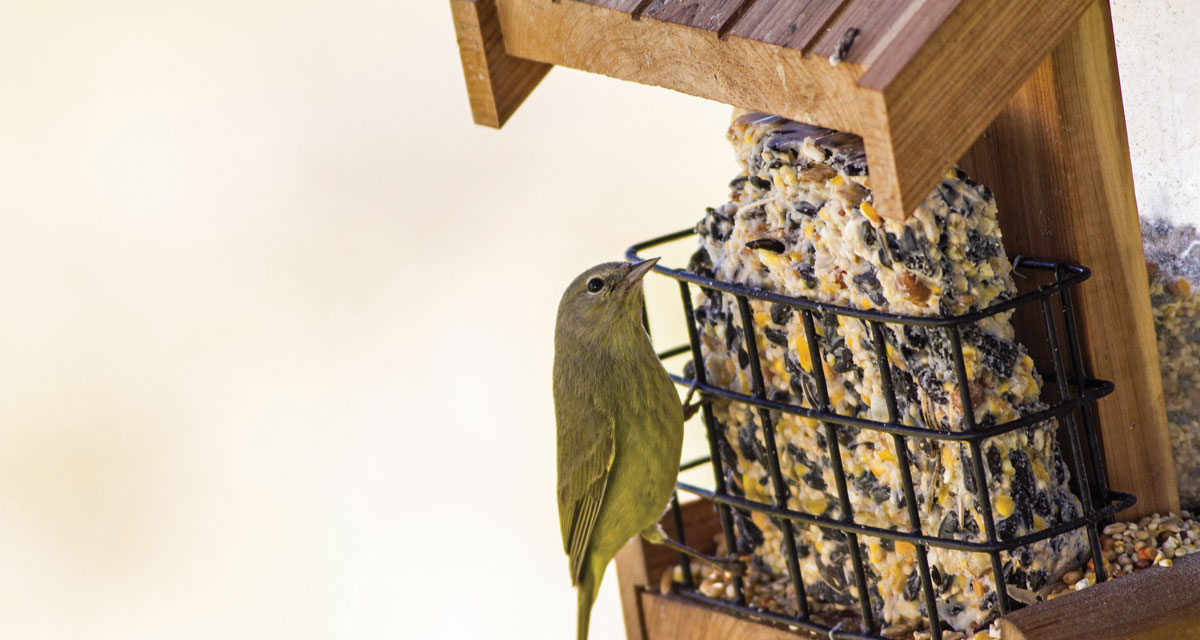Have you noticed different food added to a bird’s feeder brings in unique and diversified species? Just for the enjoyment of attracting hummingbirds and sparrows, bluebirds and chickadees, the time, effort, and money to replenish our feathered friends’ food stations are worth it. Rather than spend money on 25- to 50-pound bags of seed, you can make a nutritious treat to bring forth the birds yourself!
Why Make Suet?
In the fall and winter, birds require additional calories to maintain a certain level of energy and body heat. By creating a do-it-yourself suet cake or ball, you can eliminate preservatives, dyes, and additives.
Recipes
Step 1: Creating the suet
- Begin with a form of fat, which could be fat trimmings from beef, lard, vegetable shortening and, on rare occasions, bacon or pork drippings. While grease can serve as an occasional treat, the compounds within fried fat are detrimental over an extended period.
- Chop the fat, if necessary, until pieces are small, and then heat until liquefied. Do not use high temperatures. Stir to ensure the fat melts evenly. Strain with cheesecloth or a fine mesh several times to remove all particles or contaminants. (Freeze extra suet until needed.)
Step 2: Adding Ingredients
- One cup rendered suet, one cup melted peanut butter, three cups ground cornmeal, half cup wheat flour (cornmeal and flour create a crumble, which eases the mess and enables the birds to eat quickly.)
- One cup rendered suet, one cup melted peanut butter, three cups seeds, one cup dried fruit (such as blueberries, cranberries, and raisins), half cup wheat flour.
- One cup rendered suet, one cup melted peanut butter, one-and-a-half cups cornmeal, one-and-a-half cups rolled oats, one-third cup raisins, one cup sunflower seeds, and a half cup whole wheat flour.
Other enjoyable ingredients are dried mealworms, apple, and orange slices!
Step 3: Forming a Shape and Freezing
Before pouring into a mold, such as a chunky plastic or metal cookie cutter, spray it first. Another idea is to create a ball or block. As the mixture thickens and cools on wax paper, begin forming the hanging implement. If not tying around the shape, use a chopstick or screwdriver to create a hole through the center. Consider twine as an environmental possibility rather than fishing wire. The fibrous material also can supplement a new nest. Allow time in the refrigerator. A firm surface is an indication of readiness.
Pinecone Bird Feeders
Children can contribute to the health of your backyard feathered friends. Pinecones serve as both a feeder and the means to hold a tasty treat.
Step 1: Prepare the Pinecones
Before setting out to collect pinecones, remind the child that some have sharp points at the point of the “petals.” And, search for ones that are medium to large. Closed petals require time to bloom. Usually, the warmth of the indoors, or baking at 300 degrees for 10 minutes will warm them enough. Consider using twine to hang the pinecone.
Step 2: Adding Ingredients
Peanut butter is an enriched protein for birds. Use a large cutting board to contain the mess. A butter knife is a useful tool to coat the entire pinecone, including the cracks and crevices. (Another option is vegetable shortening.) Afterward, roll the pinecone in birdseed until completely covered. Repeat the process. Keep in mind, black oil sunflower seeds appeal to the highest number of bird species; however, altering the ingredients will attract new flyers.
Step 3: Hang Outdoors
Find a great location, high enough to eliminate the threat of dogs and cats reaching the spot. Children may require help in the final effort, hanging the bird treats for the feathered friends and bird watchers to enjoy!
Eager watchers will soon discover blends containing sunflower seeds and cracked corn bring two separate bird types. While the finches, chickadees, nuthatches, grosbeaks, cardinals, jays, woodpeckers and blackbirds consume the sunflowers, the corn, which falls to the ground, will attract sparrows, thrashers, starlings, and grosbeaks. If you are seeking to observe woodpeckers, nuthatches, and titmice, then create mixtures of nuts and dried fruit. Happy bird watching!


















